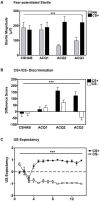Generalization of fear-potentiated startle in the presence of auditory cues: a parametric analysis
- PMID: 25368559
- PMCID: PMC4201100
- DOI: 10.3389/fnbeh.2014.00361
Generalization of fear-potentiated startle in the presence of auditory cues: a parametric analysis
Abstract
Intense fear responses observed in trauma-, stressor-, and anxiety-related disorders can be elicited by a wide range of stimuli similar to those that were present during the traumatic event. The present study investigated the experimental utility of fear-potentiated startle paradigms to study this phenomenon, known as stimulus generalization, in healthy volunteers. Fear-potentiated startle refers to a relative increase in the acoustic startle response to a previously neutral stimulus that has been paired with an aversive stimulus. Specifically, in Experiment 1 an auditory pure tone (500 Hz) was used as the conditioned stimulus (CS+) and was reinforced with an unconditioned stimulus (US), an airblast to the larynx. A distinct tone (4000 Hz) was used as the nonreinforced stimulus (CS-) and was never paired with an airblast. Twenty-four hours later subjects underwent Re-training followed by a Generalization test, during which subjects were exposed to a range of generalization stimuli (GS) (250, 1000, 2000, 4000, 8000 Hz). In order to further examine the point at which fear no longer generalizes, a follow-up experiment (Experiment 2) was performed where a 4000 Hz pure tone was used as the CS+, and during the Generalization test, 2000 and 8000 Hz were used as GS. In both Experiment 1 and 2 there was significant discrimination in US expectancy responses on all stimuli during the Generalization Test, indicating the stimuli were perceptually distinct. In Experiment 1, participants showed similar levels of fear-potentiated startle to the GS that were adjacent to the CS+, and discriminated between stimuli that were 2 or more degrees from the CS+. Experiment 2 demonstrated no fear-potentiated startle generalization. The current study is the first to use auditory cues to test generalization of conditioned fear responses; such cues may be especially relevant to combat posttraumatic stress disorder (PTSD) where much of the traumatic exposure may involve sounds.
Keywords: auditory perception; fear conditioning; generalization; startle response; stimulus; translational medical research.
Figures



References
-
- American Speech-Language-Hearing Association (ASHA) (2005). Guidelines for Manual Pure Tone Threshold Audiometry. Rockville, MD: ASHA
-
- Arlinger S. (1991). Manual of Practical Audiometry. London: Whurr Publishers Ltd
Grants and funding
LinkOut - more resources
Full Text Sources
Other Literature Sources

